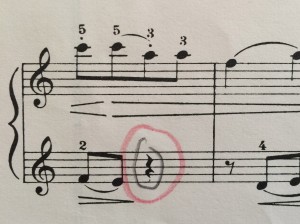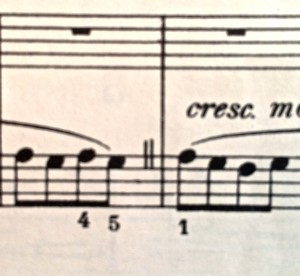Bartok, For Children Vol. I, Play-Along: Post Two (Nos. 1 – 5 Reaction)
Here we go with Volume One! If you haven’t started playing yet, don’t fret. Glance at the quick scan thoughts below and check in later for my reactions on each of the first five. I’ll be posting reactions on 5 pieces per week for the next 8 weeks.
You can read the entire Play-Along schedule HERE. Please reply here on the blog with your own reactions or on the Facebook group page HERE.
Quick scan thoughts:
The first five are certainly not presented in order of difficulty. I would classify all of them as late elementary in level, with the middle section of No. 5 leaning toward early intermediate due to its use of alternate fingers for repeated notes.
- All 5 are in the keys of C Major or A minor and hands are generally one octave apart. Melodies tend to be in the RH with some contrapuntal figures in the LH occasionally.
- Bartok was explicit in indicating tempo indications and metronome markings and as usual for him, quite precise in his indications for dynamics, articulations, tempo changes, etc.
- I notice many repeated rhythms and melodic motives and use of symmetrical phrasing such as 4mm. + 4mm. or 2 + 2 + 4. This is of course is due to his use of folk songs or dances for melodies. On either side of his phrases, he inserts small transitions, interludes, or postludes of some sort.
- Very little pedaling indicated in these first five, except at the cadences for nos. 2 and 5. One could add some additional pedaling on longer tones for warmth.
- The forms for these compositions are straightforward and easy to decipher — binary, ternary, and variations of a single theme.
- In the 1947 Boosey and Hawkes edition, I enjoyed seeing timings indicated at the end of each work. All of these are less than a minute in length, except for no. 5.
Thoughts while playing….
No. 1 – Children At Play
A charming piece, but quite intricate with all the rapidly-changing articulations (accents, hairpin cresc./dim., staccatos, tenutos, and slurs). Lots to keep track of here. The LH is is as active as the RH with its interjected commentary. Both hands have opposing articulations most of the time.
One especially tricky area in that regard is mm. 13 and 21 here.

You can see that my teacher reminded me TWICE to release the LH. 🙂 And notice how the RH slur should release quickly with a staccato while the LH should not. No one can ever claim that Bartok wasn’t detailed enough.
I found myself reading this piece much too quickly. His 92 indication is reasonable and still offers the piece an impish quality. Great piece for cheerful, quiet playing with clarity. I would definitely confirm hands-separate precision with a student before attempting HT.
The complete performance here is faster than Bartok’s indication. It was performed on Bartok’s own piano:
Faber Piano Adventures Level: Because of the active contrapuntal nature, I would place this at Level 3A to 3B. It would depend on whether or not your student has had sufficient supplementary work with moving eighth notes in each hand and interplay between the hands.
No. 2 – Children’s Song (I see “Springtime” and “Springtime Song” in other editions)
This is a commonly taught, available in several collections, and often played too quickly. Quarter note at 74 seems rather calm, but allows the piece to be more expressive. Based on a single tune, the melody is presented three times with varied harmony and accompaniment.
Quick note regarding tenuto marks (the short dashes under or over note heads):
In the piano method he wrote with Reschofsky, a Hungarian pianist, Bartok states that they should be held for their full value. They should not be struck, but instead held with arm weight to give them a “certain tonal color.” There should be some separation between tenuto notes and the ones that follow. Tenuto notes that appear before a rest should be held for full value.
In the volume, “Bela Bartok: Introduction to his Piano Works” by Willard Palmer, Mr. Palmer includes the translation of the song that was sung to this melody:
Come out, sun! Come out, sun!
Come out, sun and bring the Springtime, come out, sun!
Despite the exclamation marks, you could tell students to make the piece sound pleading rather than “loud.” According to the dynamics, this piece may never become louder than an mf.
A short video here to show how the LH should rotate in mm. 12 – 17 to achieve a smooth double-note legato:
Another view here of mm. 21-24 show how both hands would release simultaneously on the downbeats, holding quarters for their full value:
A complete video here:
Faber Piano Adventures Level: Mid-to-latter part of Level 2A or early 2B, again depending on how facile the student is with playing double notes in the LH. If you’ve been providing supplementary repertoire that moves away from a set hand position, all the better.
No. 3 – Untitled (marked “Quasi adagio”; I see “Song” in another edition, plus the sub-title “Come home, Lidi” in a different edition)
A rather plaintive chant in A minor. Several of my students have been drawn to the contemplative, dark mood of this piece. Quasi adagio fits it perfectly. It needs just a little bit of rhythmic movement for the dynamic swells to rise and fall. Excellent for teaching phrase shaping and again, double-note legato movement in the LH with slur releases.
Here’s an adult student working on that very aspect with the LH motive in mm. 11-12. She mentioned that the inward-outward arm movement she uses really does prevent her thumb from being too heavy and loud and it keeps everything moving quite smoothly.
Though Bartok doesn’t indicate pedaling, a more sophisticated player like the one in this video added some in certain areas for resonance. I would avoid pedaling during eighth notes.
Faber Piano Adventures Level: Late 2A to early 2B, as long as the student can achieve the LH reaches.No. 4 – Pillow Dance
Google says that a pillow dance is one that is danced by young girls of a village when presenting a bride-to-be with her trousseau. Now that I know this, I can completely see how this piece would be celebratory and joyous. The constant eighths with twists and turns spell “giddy” to me! Don’t you think it looks a little like Hanon?
Again I found myself reading this too quickly. It looks like a fast work. 120 is a modest tempo and much easier to handle.
Notice the dialogue between the RH and LH with the LH providing answers (almost imitatively) to the RH’s questions. Bartok wants you to clearly state the entrances of each hand especially when he provides a dynamic sign (mf) for both hands seen here:

I would have students practice each hand alone for as long it takes to reach true independence. I would work in some light wrist rotations for the eighth notes to achieve a smooth legato.
Did you notice the pause in mm. 26-27 here? 
The complete performance in this video presents an appropriate tempo, though I would have liked a longer pause and greater exaggeration in the dynamics.
Faber Piano Adventures Level: Quite a good deal of contrapuntal motion here even though the tempo isn’t terribly quick. Latter 2B Level to 3A, but if you’ve been supplementing with repertoire containing moving eighth notes, you might be able to introduce this sooner.
No. 5 – Play (also seen as “Play Song,” “A Magic Game,” and “A Magic Dance” in other editions.)
One of Bartok’s most popular educational pieces for piano. Students enjoy the rhythmic romp of this piece. The tempo changes can be tricky. The opening tempo is rather march-like (106) and many players often start too fast.
The staccato double notes in the RH should be played with an arm staccato, and the single staccato notes with alternating fingers for a crisp effect.
Willard Palmer indicates in his edition that this tune was sung with strange syllables to cast a magic spell over the dancers, hence Palmer’s title “A Magic Dance.” I will check the newer edition for any information on that.
An alternate fingering for mm. 29-32. Bartok’s is fine, but this might work better for some students:
A very fine performance here by Dr. Alan Huckleberry:
Faber Piano Adventures Level: Mid to late 2B, but keep in mind the difficulty of the RH alternating fingers for the repeated notes in the middle section.
Final Thoughts:
At this writing, I do not have the most recent Boosey and Hawkes revision in hand, the edition that you see in the sidebar to the top left. I should have it in a couple of days and will update this post if I notice new additions.
I found these unusual titles for Nos. 1 – 5 in an old Schirmer edition: 1. Sweet Cakes 2. The Sun is Out 3. Lost Loves 4. Where is My Hankie? 5. Circle Dance (highly romanticized, I really prefer Bartok’s titles).
Which of the 5 have you taught before and would recommend to others? Or…if you haven’t taught them before, which of these would you be inclined to teach?
Coming next Monday….Nos. 6 thru 10. Enjoy!










I have taught ‘Quasi Adagio’. (As a levelling guide it was actually a Grade 1 exam piece for one of the UK examining boards a few years back). Thanks for all the useful pointers above.
You’re most welcome, Michele! Thanks for informing us about the UK level. Is there some kind of guide to UK level characteristics or their correlation to any of the American method books? Just wondered….
Thank you for the teaching tips and videos! I have taught no 5, and I’ve always liked no 3.
No. 3 is so beautiful. I like that it’s untitled. Allows me to tell students to express their own ideas in their playing.
I have never used any of Bartok’s pieces. Thank you for the introduction. I think all of these would work in my studio with No. 1 being at the bottom of the list, however. My favorites are Nos. 3 – 5.
Thanks for your input, Shirley!
Elizabeth – sorry for the delay in replying. Incidentally, I have also just realised that the new syllabus for 2015 ABRSM Grade 1 exam pieces includes ‘Children at Play, No. 1’ {on the list of ‘other pieces’, ie alternative exam pieces which are not in the main compilation exam book published by ABRSM} You pose a great question and I wish I knew the answer! As far as I’m aware, I don’t think there is actually a list of criteria for each grade of exam pieces – albeit the pieces are selected by ABRSM with a very thorough, balanced approach. However, there are very precise, detailed descriptions for the sight-reading, aural & scales sections of the ABRSM graded exams. I’m not very familiar with American Method books but I think ABRSM Grade 1 is approximately Level 2B – Level 3A of Piano Adventures. I usually firstly cover semiquavers, dotted crotchets, dotted quavers, and very simple key signatures (with one or occasionally two sharps or flats). The set pieces change every two years – some years the pieces include 3/8 or 6/8 time or swung quavers. I have often tried to define the criteria for myself but each set of new pieces seems to vary! Perhaps someone else in this group knows more than me about this?…as I would also love to know!
Thank you, Michele, for looking into this. I can certainly understand how the ABRSM levels can vary from year to year. That occurs often here in the U.S. as well. Can be quite frustrating. I was just searching now on the Alfred website. I recall seeing a chart on their site once that showed how their method books or grading levels correlate to UK levels. I am unable to locate it right now. Perhaps I dreamed this?….
If anyone else knows of any sort of correlation chart, please inform. Thanks!
I’m joining late! I was previously unfamiliar with any of these, and I particularly enjoyed Nos. 3 and 5. Any of them would seem to be a fantastic exercise in phrasing.
I am curious is you are using a staccato touch on the notes at the ends of slurs, or more of a “play and hold for slightly shorter than full value, then lift”. In No. 2. measure 1, my inclination, due to the temple and overall feel of the piece, was to not have a sharp staccato at the end of the 2-note phrase. My favorite part was trying to be precise in No. 5 measures 1-2, 5-6, etc. where the LH has a staccato but the RH simply lifts from the slur. (Am I correct in assuming the LH staccato should be sharp/short while the RH note should sustain slightly longer and then lift off before beginning the next phrase?)
Hi Valerie! Thanks for joining up and sorry for this late response. Follow along in January 2015 when we wrap up the Bartok Play-Along. In no. 2, I agree that the lift on the 2-note slur should only be a wrist lift and not a staccato followed by a lift. I often tell my students just to execute the lift (forward wrist lift) and it will be “naturally short.” I also tell them not to make a “jerky lift,” or else the end of the slur will sound staccato. We often experiment with what to do vs. what not to do. They understand the difference this way. As for No. 5 where there is RH lift while the LH plays staccato — this is a trickier coordination. Here I tell my students that it’s OK if the RH slur ending has a “staccato lift.” My rationale is the tempo. Due to the Allegretto, it will naturally sound shorter anyway, and personally in this instance, I think it sounds better if RH and LH release at the same time. I hope this makes sense. Thanks for your observations! Good points.